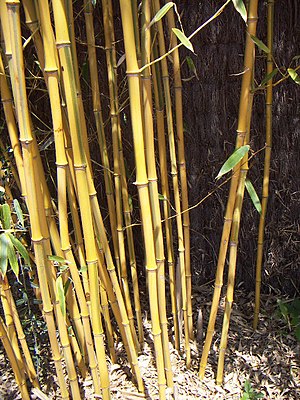Phyllostachys aureosulcata
| Phyllostachys aureosulcata | ||||||||||||
|---|---|---|---|---|---|---|---|---|---|---|---|---|

Culms of Phyllostachys aureosulcata 'Spectabilis' (variety) |
||||||||||||
| Systematics | ||||||||||||
|
||||||||||||
| Scientific name | ||||||||||||
| Phyllostachys aureosulcata | ||||||||||||
| McClure |
Phyllostachys aureosulcata is a bamboo - type of the genus Phyllostachys .
description
Phyllostachys aureosulcata has an upright growth and the stalks reach heights of up to 10 m under optimal conditions, in Europe mostly only 7 to 8 m. They can be 30 to 40 mm thick in fully grown plants. The stalks of the species are bright to olive green with a yellow sulcus (notch). The different varieties are sometimes very spectacularly colored. B. the cultivar P. aureosulcata 'Aureocaulis' has bright yellow stalks, P. aureosulcata 'Spectabilis' has light yellow stalks with a green sulcus. The yellowish stalks often turn red when exposed to sunlight. The internodes are up to 40 cm long. The base often has one or two curved internodes, the stalks show a pronounced zigzag growth. The sheaths are purple-green, smooth, often striped yellow with small brown spots. The leaves are 10 cm long and 1.2 cm wide. Like all Phyllostachys species, the bamboo has a leptomorphic rhizome and forms many runners .
The number of chromosomes is 2n = 48.
distribution
Phyllostachys aureosulcata grows in the Chinese provinces of Jiangzhu , Zhejiang and Anhui .
etymology
aureus ( Latin ) means “golden”, aureosulcata means something like “golden furrowed” or “with a golden sulcus ”.
Culture and use
Phyllostachys aureosulcata is hardy and can withstand temperatures of −18 ° C to −24 ° C. This type of bamboo is only used as an ornamental plant.
literature
- Simon Crouzet and Oliver Colin: Bambus , Agrarverlag 2003, ISBN 3-8001-4195-7 .